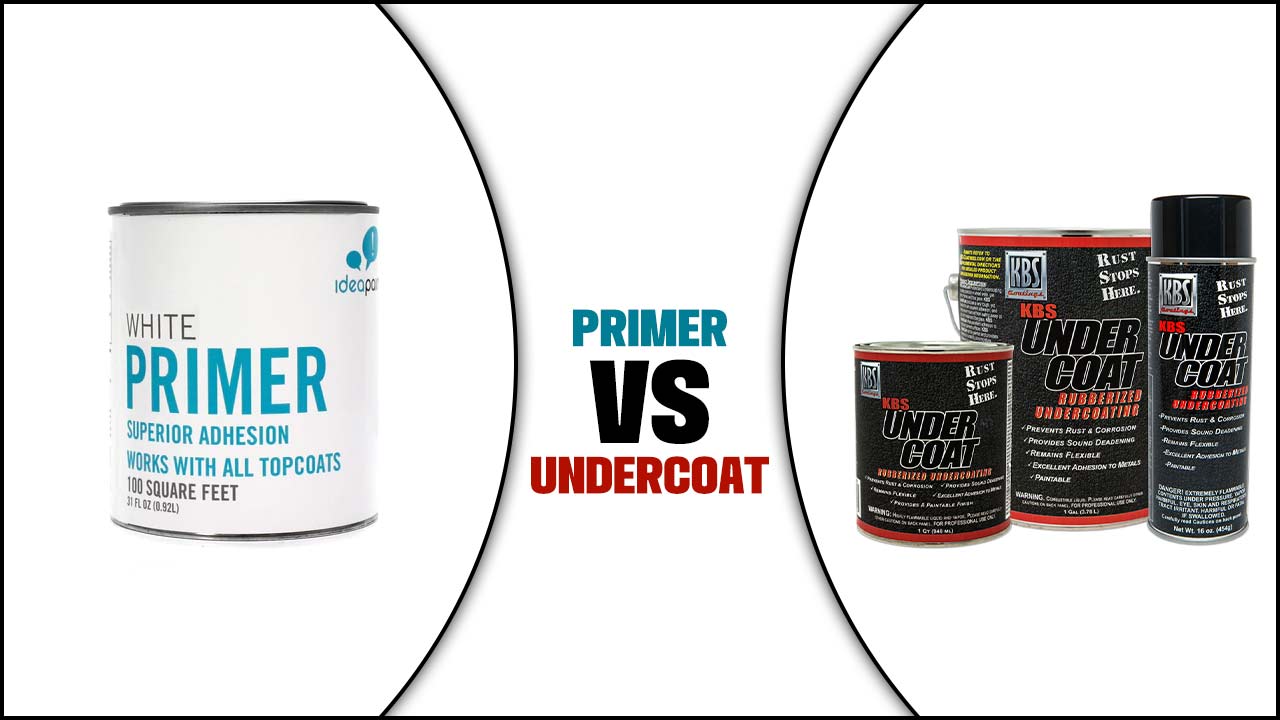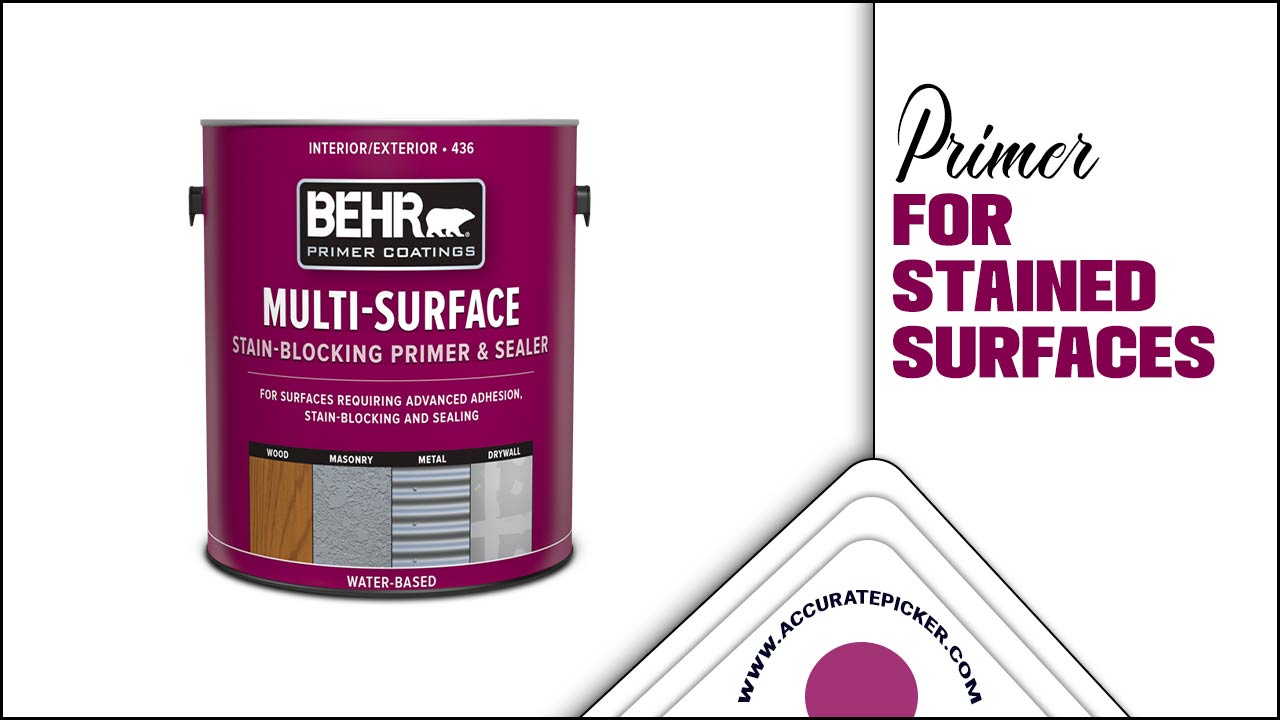If you are a busy bee, weekends are the only break for keeping up with your delayed projects. Repairing a car is tough while preparing spray guns adds additional hassle. So if you’re holding up that repair work to avoid the fuss, here is a quick solution.
The weld through primers is designed to provide you durability and protection from rust. The nozzle is easy to handle, which makes your job a piece of cake. So why go back to spray guns, just spray prime your car! So, what are the best weld through primer?
There are a variety of primers available. But we will help you choose the fittest one for your project. Here we mentioned some of the best weld-through primers you can find in the market.
Let’s check them out!
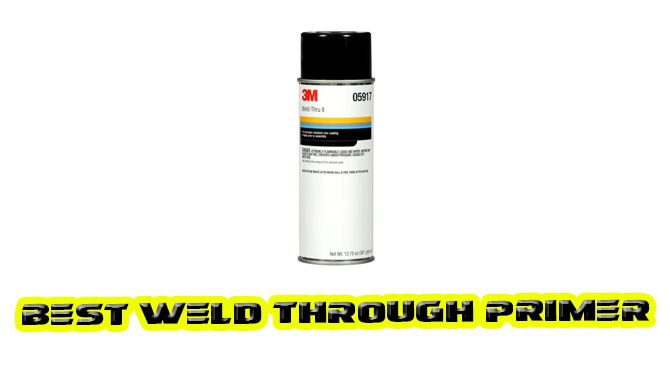
Which Type Of Weld Through Primer Is The Best?
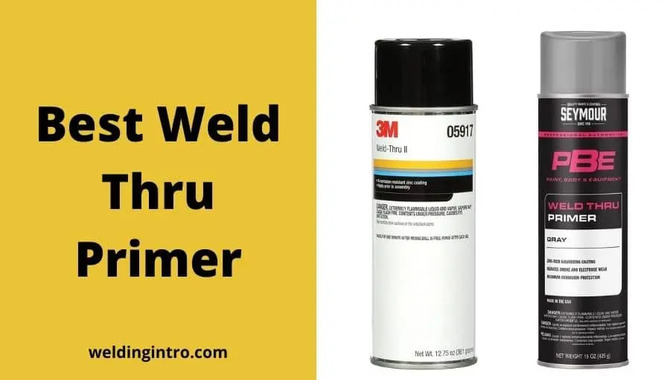
It is a tough call choosing between zinc-based primer and copper-based primer. Copper’s melting point is similar to the welding temperatures on steel.
Zinc is much lower than that. So copper residue remains even after welding, whereas zinc burns off. However, zinc plating provides more corrosion protection in the long run.
Owing to the fact that corrosion and rust are steel’s biggest enemies, zinc will provide long-term protection.
Although zinc primers have some drawbacks, the benefits outweigh them. Thus zinc-based weld through primers is best.
5 Best Weld Through Primer Review
1# Seymour 20-1675 PBE Professional Primer, Self Etching/Weld Through Gray

Primers that save your time are your best bets. Because these weld-through primers will cut your labor in half and save time, is it possible? Yes, it is!
Seymour 20-1675 PBE primer is self-etching so that you can prepare your project with minimal sanding. The primer is acidic, so the zinc can set on the surface better as it would after abrasive blast treatment. So you can skip this step without worry.
It is also durable. Thus it protects the surface from mild physical damages. The zinc also protects the surface chemically.
The zinc reacts with the air to form zinc oxide ( ZnO) as a sacrificial layer. This layer protects the metal from rust—so no need to worry about rust creepage.
Even after you scratch the surface, the primer will keep protecting it with its electrochemical galvanic action. Thus your metal surface is fully protected after damage.
The dry film is 86 Percent pigment, thus resulting in less smoke and electrode wear when welding. People with more exposure to these substances favor primers like this for their health safety.
It is heat resistant to 250° F. This means in extreme conditions like overheating, and your car will not affect its services.
The primer comes in a can and sprays like a gun to give you a professional-looking coating. The nozzle prays fast and heavy. Thus only two coatings are enough. It builds nicely, lays down correctly, and sands as mentioned on the can.
It is specially formulated for the performance wanted by body shop personnel. So a home handyman or a professional can opt for it.
Pros:
- The primer has self-etching properties, which help replace the need for sandblasting thin sheet metals and tubing.
- It is durable and has a galvanizing effect which will protect the surface even after you scratch it.
- It saves your welding equipment by lessening electrode wear when you weld.
- The dry film has large amounts of pigment in the dry film, which results in less smoke; thus, you inhale less toxic gas at the time of welding.
- It is suitable for application on various metals like steel, aluminum.
Cons:
- Higher than recommended film builds will delaminate coating that you might apply afterward; thus, nothing more than a thin layer of it is necessary for your metal surface.
- Bare metals are preferable for this primer. So previously painted surfaces need slight sanding.
Verdict:
It is excellent for amateur welders who might not know the proper cleaning process. The electrochemical galvanic protection keeps the rust away.
2# Seymour 16-845 Primer, Spray Weld Through

When you are repairing your favorite car, you prefer the best protection for the parts. So it doesn’t have to go through another replacement soon. The best protection for welding your car is a weld-through primer with zinc galvanized finishing capability.
It delivers or transcends the performance from the demands of ASTM A780, DOD-P-21035A, MIL-P-46105, MIL-P-26915C, SSPC-Paint 20. Thus the zinc galvanized protection meets the military standards. This will take the durability of your car surface to the next level.
It is a cold primer for galvanizing that has 86% type I inorganic zinc when dried. This ensures the metal underneath is protected from rust. Zinc plating spray lays a sacrificial layer on top of the metal. The zinc reacts with oxygen existing in surrounding air to form zinc oxide.
Which also acts as another layer of protection on top of the zinc. Zinc plating is the best protective coating for your automotive parts. If you accidentally scratch the surface, there is no need to redo the primer because the galvanizing effect will protect the pipes’ small bare areas and edges.
You also can use it for topcoats. This will provide maximum durability to your car parts. While welding car parts, it protects the face tip from electrode wearing because of its unique formula.
When we weld zinc, it gives off toxic fumes that are hazardous for the worker’s health. But this formula results in less smoke. Thus you have less exposure to toxic vapor.
Seymour primers are not comprised of lead, cadmium, mercury, chromates, and chlorinated solvents. So you can work in a safe, non-toxic environment because your health is the priority.
Pros:
- The formula of this primer is specially designed for durability and sustainability of the surface, which will remain rust-free for long.
- It is flexible and sandable so that you can add the following layers with ease.
- The cold galvanized zinc also protects the edges where the spray couldn’t reach; thus, it protects your metal surface at every corner.
- It is also applicable as a top coat so that you can protect the paint underneath.
- This primer can work on metal and wood; thus, it is usable for your metallic and wooden projects.
Cons:
- Zinc-based formulas tend to produce a little more spatter than others. The weld does not look very neat as pro welders.
- Zinc causes adhesion issues for paints or other subsequent coats if you skip sanding the primer.
Verdict:
Seymour is a well-known company for its variety of spray paints and primers. Their formulas are lead, cadmium, mercury, chromates, and chlorine-free. Thus the primers are eco-friendly and durable for your automotive parts.
3# U-Pol Products 0768 Zinc/Copper WELD#2 Weld Through Primer

Their color can distinguish superconductive copper primers. Pure copper provides superior electric conductivity that makes your welding process faster.
The U-Pol WELD#2 primer predominantly consists of copper. It also contains zinc. Due to its unique feature mentioned above, it minimizes the heat zone. That results in faster heat-up and concentrated heat where it is necessary.
It is specially formulated to generate less spatter around the welding arc. So you can maintain a neat workstation and save time from the cleaning fuss after welding.
Copper has an excellent adhesion capacity to metals. This quality makes this primer bond to the bare metals with a firm grip. So there are fewer chances of scratching the surface.
It provides superior rust protection for SPOT, MIG, and TIG welding applications. This is the best weld though primer when you are using a spot welder.
It provides a long-lasting, semi-flexible metallic finish. This adds corrosion protection from harsh environments for an extended period.
No corrosive by-products are produced when welding takes place. This minimizes the chances of corrosion from the beginning.
It also has high heat tolerance. At the same time, you are welding heat transfers to the back of the adjoining metals.
The best primers do not burn off entirely from the head applied zone. The traces of the remaining primer will protect the welded seam in the long run.
It is suitable for overlapping joints as it will save the disclosed portions of the welded parts. Also, it has a clog-free nozzle. Therefore it allows the spray to shoot for a longer period. You will be able to finish the project timely.
Pros:
- The copper-based formula doesn’t burn off entirely from the weld zone and back of the welded area. Thus the protective layer is present even after welding, which provides corrosion protection long term.
- The formula creates comparatively less spatter, which leaves a neat and clean weld that makes you look professional.
- It has great adhesion capacity because it is made of copper, so you don’t have to sand the layer.
- The nozzle is clog-free so that you can use the entire can without any hassle.
- Usually, primers are not suitable for MIG welding; however, this primer will accommodate your MIG welding.
Cons:
- The metallic copper color might not be suitable for black or blue auto body parts, which gives your project an inconsistent look.
- The cost is higher per unit in comparison to other weld-through primers; thus, it will cost you a lot.
Verdict:
Zinc primers have been around for a long. But copper primer is gaining popularity among the crowd because of its adhesion capacity and high heat tolerance. If that’s what you’re looking for, this is the primer for you.
4# 3M Weld-Thru Coating II

3M is a great company that applies Innovation and science to make a real impact on communities and lives across the globe. Their weld through primer is also an example of innovative 3M science.
The Weld-Thru Coating II uses the science that lies behind the bimetallic or the contact corrosion in-order-to eliminate rust and corrosive effects from raw bare metals.
Thus your sheet metals, panels, and overlapping welding joints are free from corrosive substance exposure.
This weld through primer shields untreated the metal panels and the parts from rusting after welding. So you can keep comebacks to a minimum.
The primer is a formula with a zinc base that leaves the corrosion contact. This leaves the substrates strong and rust-free.
The aerosol spray is convenient and user-friendly. You don’t need brainstorming to use it.
The primer needs to dry for only 5 minutes before the MIG welding for getting an efficient throughput. This primer can significantly benefit the busy collision repair shops. It cuts the drying time short and expedites the entire welding operation.
3M uses a formula that minimizes weld spatter when welding. This saves the technicians from burns and the shop from additional nuisance.
The 3M primer professional-grade thus helps to ensure a strong joint at the welds, so your customer base is always strong as well. It helps to ensure fewer comebacks to shops and earn you the best welders’ title.
Pros:
- It helps prevent corrosion by using the science behind bimetallic or contact corrosion. Thus the formula effectively prevents rust and decay of your metal surface.
- The formula takes only 5 minutes to dry. It speeds up the entire welding process so that you can finish your project early than usual.
- Less spatter gives the welded project a professional and clean look which will ensure your customer satisfaction.
- The zinc-based formula protects body panels and sheet metals from corrosion, ensuring a minimum visit to repair shops.
- This primer is easily useable on non-weld metal surfaces with 3M Rust Fighter-I, 3M undercoating products, so you don’t face any adhesion issues with this versatile primer.
Cons:
- Some users faced issues with the nozzle that clogs very quickly, which means you have to get a replacement.
- The primer might leak rather than coming out of the nozzle, which creates a mess.
Verdict:
3M is a renowned company for which formulates science-based products. Their weld through primer is one of their proud formulations. You can put your trust in them for the best corrosion and rust protection.
5# Dupli-Color EDPP108 Weld Thru Cold Galvanized Primer

If you were to name one fundamental feature that a weld through primer should have? It should be resistant to corrosion.
The primer that serves this purpose for the long term is the one that ensures you don’t need to visit the repair shops again and again.
This Dupli-Color EDPP108 Primer is designed to provide maximum corrosion resistance when welding on bare sheet metals and overlapping sheet welding.
It reaches areas where it is hard to get to. The primer provides long-lasting corrosion protection even in harshest environments.
It is a cold galvanized primer with zinc that protects from rust that your automotive parts need for the long run.
The weld through primer specially features a rich zinc coating applied directly onto dry metal or galvanized surfaces. This means if your repair surface is clean, the primer will adhere firmly.
Also, if the repair surface is galvanized, the primer will adhere as well. It eliminates the need to remove the galvanic coating, thus making the welding process easier and faster.
It is a durable product that will protect your metal surface from damage. The nozzle shoots thick, even layers to thoroughly coat the metal. Hence speeds up the laying process for you.
Dupli-Color Weld through Cold Galvanized Primer provides an excellent feather edging. It levels and smoothens the surface for sanding. Accordingly, it is perfect for applying your top finishing coat of paint.
The weld-through primer is relatively pocket-friendly than other weld-through primers that offer the same service at a higher price point. So you get the most bang for your buck.
Pros:
- The primer gives supreme corrosion protection that will protect your sheet metals and auto parts from adverse environments.
- You can apply it on the galvanized surface; thus no need for sanding, and you save a lot of time.
- The nozzle is easy and clog-free. This will make your work easy and hassle-free.
- It is very cost-effective. It gives high-quality protection at a low price point.
- It is suitable for coastal areas where the air is humid. So if your project is going to stay in that zone, this primer has got your back.
Cons:
- It creates a good amount of spatter that doesn’t produce a neat look you might prefer.
- It shoots jet-style spray, so it may be hard for you to get a thin coat from this primer.
Verdict:
Although some users underestimated the primers right after welding, they loved it when it didn’t corrode the steel in 2 weeks! Some even tested it for 3 months, and the result was outstanding.
It prevents rust and corrosion even in humid environments, making it the top weld through primer if you’re looking for long-lasting effects.
Top Weld Through Primer Buyers Guide
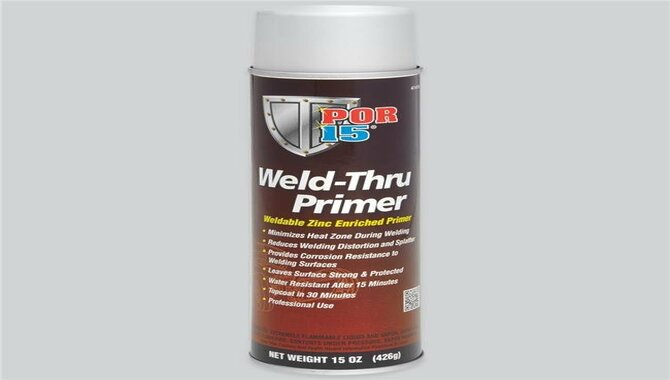
There is a wide array of weld-through primers in the market to choose from. It is hard to decide on a primer that will serve your particular purpose.
Therefore we have sorted out specific points that are essential for buying a weld through primer. The right primer will save you from regrettable trips to the auto body shop for a long time.
Types of Weld Through Primers

- Zinc weld through primer
- Copper weld through primer
- Weld through primer with self-etching properties.
Picking out the suitable weld through primer will not only shield your seems for an extended period but also will amp up your welding game! Let’s get into the details.
Corrosion Protection
The first and foremost function of a weld through primer is to defend the underlying metal from corrosion. Corrosion accelerates fatigue crack growth in structural steels.
It is vital for the steel structures to have a protective barrier between the exposed Iron (Fe) and circumambient vapor, steam, and immersion.
If you anticipate long-term corrosion protection, zinc-based weld-through sprays are preferable.
Although it also depends on the formula of the primer, still zinc weld through primer is the best plating for your overlapping sheet metals. Also, undisclosed automotive parts are hard to reach after welding.
Suppose you plan to add subsequent layers of protective layers as paint. In that case, you can turn to copper primers or self-etching primers to accommodate the applications.
Adhesion
Zinc has poor adhesion capability. That is why you might feel skeptical about using the zinc-based formula on your bare metal. In that case, you can choose to buy copper-based primer as a galvanizing coat. Copper has better adhesion properties than zinc.
But you might need another layer of paint on top of it to fully guard the surface. Additionally, self-etching primers are a multifunctional formula that etches the surface for better adhesion of the zinc-based primer. You can save some elbow grease, including the benefits of zinc with this primer.
Spatter
Zinc weld through primers tend to flow in the welding pool more than copper primer because of its lower melting point. Hence it creates more spatter around the arc, which gives an unprofessional look.
Regarding the technicians’ safety and the cleanliness of the workstation, you might prefer buying copper or self-etching primer. If you can look past these minor details, you can give the zinc primer a try.
Application
Ease of application is mandatory for the spray can weld through primers. The spray can be jet style and heavy or fan style and light; when buying, look for a clog-free nozzle.
It will help you to utilize the whole can. Otherwise, the nozzle will stop working and will leave you with a costly mistake.
FAQ’s
1.Do You Need To Use Weld Through Primer?
Ans: No, and yes. Not all cases of welding require weld through primers. Only overlapping panels, hard-to-reach areas that need protection from corrosion and rust need primers. These areas need a sacrificial layer to prevent degradation after welding.
2.Can You Weld Through Primer?
Ans: Weld through primer is a contaminant that makes the weld porous and brittle. So you have to clean the spot where you will perform the weld. The primer should not be directly on the welds.
3.How To Use Weld Through Primer?
Ans: Shake the can before application. Thoroughly clean the bare metal surface. Apply the primer. Wait for it to dry. Then add another layer of primer. It will be dry to the touch after a while.
Afterward, wait 30 to 1 hour before the welding process. Weld through primer is not a paint primer, and paint will not adhere to most primers. Thus clean the surface before applying paint.
4.Where Do You Apply Weld Through Primer?
Ans: The weld through primer causes adhesion issues. Thus it has to be applied to the heat-affected zone (HAZ) only. Apply it where you cannot paint and want to add protection from corrosion.
Final Thoughts
Whether you’re welding sheet metals or automotive parts, if it starts to crumble at the seams, they will not last. The weld through primer aids to keep those bonds strong for long.
So you don’t have to worry about your favorite car parts wear out even in the harshest environments. You will know that you have provided the best protection to maintain its value.
If you leave it out, the rust may decay the metal down the road, which will leave you with regret and expensive trips back to repair shops. Isn’t it better to take the initiative sooner rather than later? I hope now you know about what are the best weld through primer.

![5 Best Weld Through Primer [Reviews With Buying Guide]](https://accuratepicker.com/wp-content/uploads/2022/03/Best-weld-through-primer.jpg)
